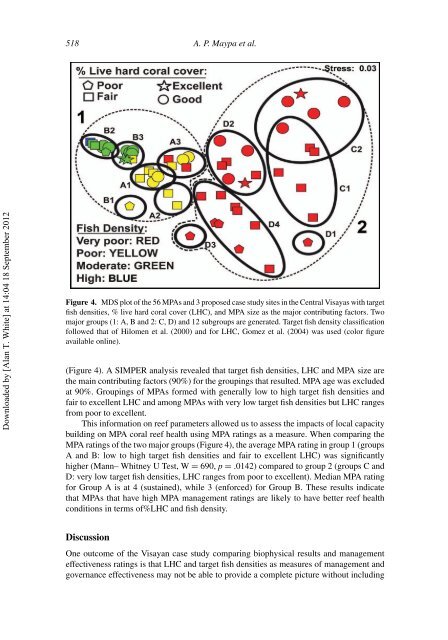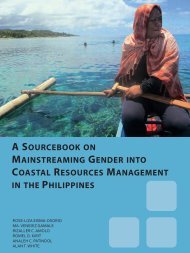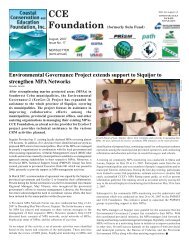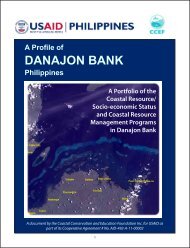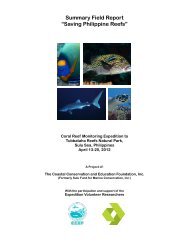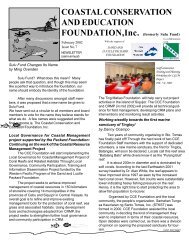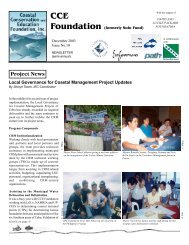Marine Protected Area Management Effectiveness: Progress and ...
Marine Protected Area Management Effectiveness: Progress and ...
Marine Protected Area Management Effectiveness: Progress and ...
You also want an ePaper? Increase the reach of your titles
YUMPU automatically turns print PDFs into web optimized ePapers that Google loves.
Downloaded by [Alan T. White] at 14:04 18 September 2012<br />
518 A. P. Maypa et al.<br />
Figure 4. MDS plot of the 56 MPAs <strong>and</strong> 3 proposed case study sites in the Central Visayas with target<br />
fish densities, % live hard coral cover (LHC), <strong>and</strong> MPA size as the major contributing factors. Two<br />
major groups (1: A, B <strong>and</strong> 2: C, D) <strong>and</strong> 12 subgroups are generated. Target fish density classification<br />
followed that of Hilomen et al. (2000) <strong>and</strong> for LHC, Gomez et al. (2004) was used (color figure<br />
available online).<br />
(Figure 4). A SIMPER analysis revealed that target fish densities, LHC <strong>and</strong> MPA size are<br />
the main contributing factors (90%) for the groupings that resulted. MPA age was excluded<br />
at 90%. Groupings of MPAs formed with generally low to high target fish densities <strong>and</strong><br />
fair to excellent LHC <strong>and</strong> among MPAs with very low target fish densities but LHC ranges<br />
from poor to excellent.<br />
This information on reef parameters allowed us to assess the impacts of local capacity<br />
building on MPA coral reef health using MPA ratings as a measure. When comparing the<br />
MPA ratings of the two major groups (Figure 4), the average MPA rating in group 1 (groups<br />
A <strong>and</strong> B: low to high target fish densities <strong>and</strong> fair to excellent LHC) was significantly<br />
higher (Mann– Whitney U Test, W = 690, p = .0142) compared to group 2 (groups C <strong>and</strong><br />
D: very low target fish densities, LHC ranges from poor to excellent). Median MPA rating<br />
for Group A is at 4 (sustained), while 3 (enforced) for Group B. These results indicate<br />
that MPAs that have high MPA management ratings are likely to have better reef health<br />
conditions in terms of%LHC <strong>and</strong> fish density.<br />
Discussion<br />
One outcome of the Visayan case study comparing biophysical results <strong>and</strong> management<br />
effectiveness ratings is that LHC <strong>and</strong> target fish densities as measures of management <strong>and</strong><br />
governance effectiveness may not be able to provide a complete picture without including


